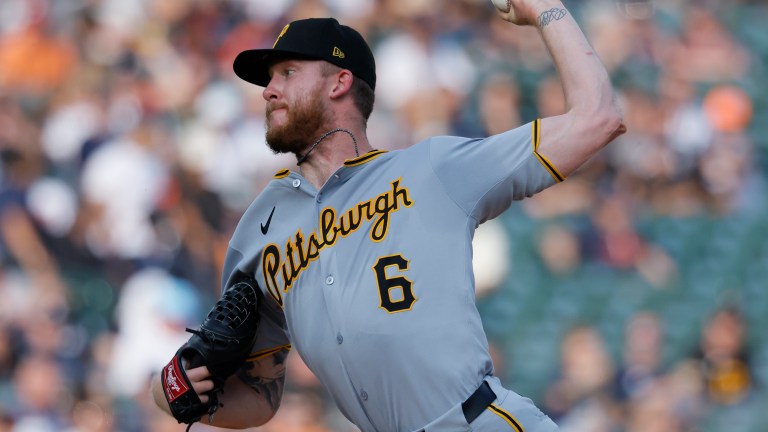Kansas City Royals Checked All the Boxes at the Trade Deadline
With several needs to address at the trade deadline, the Kansas City Royals were active and managed to address their roster's shortcomings.

After heading into the All-Star break with their second-half direction up in the air, the Kansas City Royals had a crucial decision to make at the trade deadline.
Would they cave into their losing record and scuffling offense and divert their focus to competing in 2026, or would they look take advantage of opening their competitive window in 2024 and not squander 2025 by assuming the role of buyers?
J.J. Picollo and Co. chose the latter and wasted no time in making a splash in the second half. It may have been a small splash, but the acquisition of a rental utility bat in Adam Frazier signaled that perhaps the Royals were gearing up to attempt to make a push.
Then, the weekend before the deadline, the Royals eliminated all doubt on what direction they were assuming for the rest of 2025, after trading for Randal Grichuk and then taking Seth Lugo off the trade block the next day with a multi-year extension.
While choosing a direction is one thing, entering Thursday’s deadline, there was still work to be done.
The Royals were faced with the reality of an outfield that even after the Grichuk addition still had some glaring holes and a starting rotation that lacked depth with three of their key starters on the IL in Cole Ragans, Michael Lorenzen and Kris Bubic.
These were the needs the Royals had to address come deadline day if they had any desire to really make a legitimate push for the postseason.
Fortunately for the Royals, their front office to work and made a series moves to address each of these pressing matters.
The Royals Took Strides to Strengthen a Struggling Outfield
The Royals currently hold the worst outfield in baseball when it comes to wRC+ (61), OPS (.593), HR (20), and RBI (82). While Grichuk and his 97 wRC+ and .735 OPS address these offensive woes, a near-average hitter won’t solely solve their issues; more work is needed.
Given their inconsistent start to the season and current losing record, it wasn’t realistic to think that the Royals would be all-in on the top outfield names on the market Steven Kwan or Jarren Duran. Mortgaging the future with a 54-55 record and multiple teams to climb before they reach the Wild Card spots seems unwise.
This meant players like Grichuk – near average, potentially platoon level bats – seemed to be the logical route.
While they may have waited until the last minute to pull this deal off, they did so by acquiring Mike Yastrzemski from the San Francisco Giants.
Yastrzemski’s not anything to write home about but he’s a near average hitter with a 97 wRC+, has a good eye at the plate with an 88th percentile walk-rate of 12.6% and has traditionally been a decent source of power with 15+ HR in each of his first six seasons before this season.
For a team that struggles with hitting for power, drawing walks and just producing anything close to average offensively at times, Yastrzemski offers another breath of fresh air to Grichuk, adding some stability so that the reliance on inconsistent hitters like Kyle Isbel and John Rave isn’t as heavy.
In the meantime, he lines up well to likely assume the more everyday role of right field while Jac Caglianone is on the IL. Then, after he returns, his splits as a left-handed bat line up well with Grichuk’s splits as right-handed hitter to form a decent corner outfield platoon.
To acquire half a season of Yastrzemski, as he’s an impending UFA this winter, the Royals had to give up arguably their biggest piece of the day in Yunior Marte. The 21-year-old right-hander is crafting a great season in Low-A Columbia, posting a 2.74 ERA, 3.10 FIP, 0.99 WHIP and .204 BAA across 19 starts.
However, he’s not one of the Royals upper echelon names, so the fact the Royals were able to improve their outfield, even if it’s just in the short-term for the time being, and not have to surrender a Top 15 prospect seems worth it. They addressed a need now while not mortgaging the futiure.
Royals Went From Starting Pitching Shortage to Surplus
As mentioned before, the Royals had two holes in their five-man rotation with three of the six main arms they’ve used at the major league level this season. Two of which they hope to get back this month in Ragans and Lorenzen, but unfortunately, one that will be out for the rest of the season in Bubic.
They’d been filling the gaps with either bullpen days or spot starters like Rich Hill, who had varying degrees of effectiveness – Rich Hill was DFA’d on Tuesday, but the bullpen put up 10 shutout innings on Wednesday. Neither of these options, though, spelled a consistent strategy for a team with postseason aspirations in mind.
However, they entered the day with a shortage of starting options, but left with a surplus after a pair of moves brought in three names.
The first was a deal with the San Diego Padres that saw right-handers Ryan Bergert and Stephen Kolek acquired from the San Diego Padres in exchange for catcher Freddy Fermin.
While it remains to be seen whether or not Bergert and Kolek play an immediate role in the majors, the fact of the matter is they are strong depth capable of putting together solid big league outings when called upon.
In 35.2 innings across 11 appearances (seven starts) with the Padres, Bergert’s thrown to a 2.78 ERA, 1.18 WHIP, and .185 BAA. He also manages to limit quality contact with a 75th percentile hard-hit rate and 65th percentile barrel rate.
Then after an uninspiring 5.21 ERA in 42 relief appearances last year, Kolek moved into a starting role this season. Through 14 starts in San Diego, he’s tossed to a respectable 4.18 ERA and 4.23 FIP.
They’re not groundbreaking names, but they’re exactly what they needed: more reliable pitching depth, especially since the options depth in Omaha isn’t very convincing this season.
The fact that they only had to give away a backup catcher with offensive limitations (.648 OPS, 78 wRC+) in Fermin, who also happens to have little hope for a longer-term future with the club due to the rise of Carter Jensen, makes this deal seem like a no-brainer.
Then came the deal that will make an immediate impact on the Royals’ rotation, no questions asked. At the final stages of the deadline, Kansas City managed to sneak in a deal for the Pittsburgh Pirates’ left-hander Bailey Falter.
There’s not a ton to be excited about his games, as nothing in particular jumps off the page about him from an underlying metrics perspective. However, all of that doesn’t matter when you’re a sub-4.00 ERA (3.73) arm with a 1.18 WHIP and .228 BAA that eats innings (113.1 across 22 starts this season).
Seth Lugo, Michael Wacha and Noah Cameron will be tasked to hold down the fort at the top of the staff, but Falter is more than capable of manning the bottom portion.
And to acquire three years of a capable innings eater all it took was “Quad-A” type reliever in Evan Sisk and a 2024 undrafted free agent first baseman in Callan Moss.
Sisk has spent the majority of the year in Triple-A Omaha, throwing to a 3.77 ERA across 31 relief outings. He has, though, spent some brief moments with the Royals this season.
In his time in the bigs, he had his pros and cons. He was a sub-2.00 ERA arm with an 18.56 K/9 rate; however, he was also sporting a 1.88 WHIP thanks to some control issues that saw him also hold an 8.44 BB/9 mark.
In the end, he was simply not up to the same standard as other big league call-ups this year in Steven Cruz, Taylor Clarke, and Jonathan Bowlan, thus making him expendable, especially with all the new pitching depth.
There’s Callan Moss, who is having a great season in High-A Quad City, highlighted by a .270 AVG, .790 OPS, 70 RBI, 14 swipes, and a 123 wRC+. Great numbers, but at the end of the day, he’s an undrafted free agent with no real prospect pedigree placed upon him yet, making him expendable for three years of Falter.
Where Do the Royals Stand Now?
The hard work for the front office is done. They’ve done all the hard work they can to this point; now it’s a matter of whether or not these acquisitions can gel and continue to keep their recent momentum up after three-straight series wins and a 15-9 record to end the month of July.
It’ll be up to the players now, but it’s safe to say that they now have plenty of tools and support to make a significant push to the postseason.
